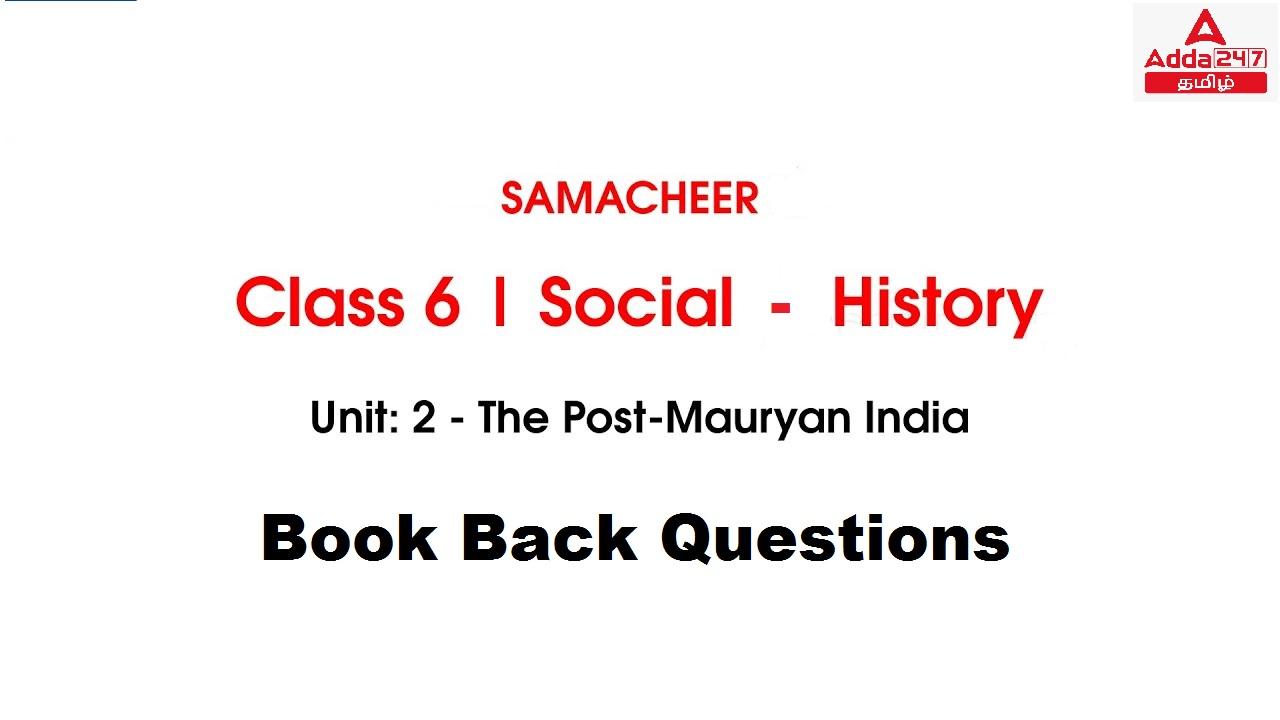TNPSC Samacheer Book Back Questions: ADDA 247 Tamil is giving you TNPSC Samacheer Book Back Questions – The Post-Mauryan India MCQs for all competitive exams. Here you get Multiple Book Back Choice Questions and Answers. Here you will find all the important questions and answers that will help you increase your knowledge and move you toward fulfilling your goals. Study these TNPSC Book Back Questions MCQs and succeed in the exams.
Attend TNPSC Book Back Question Quiz Here
Choose the correct answer
Q1. The last Mauryan emperor was killed by_________.
(a) Pushyamitra
(b) Agnimitra
(c) Vasudeva
(d) Narayana
S1.Ans.(a)
Sol.
- The last Mauryan emperor, Brihadratha, was assassinated by his own general, Pushyamitra Sunga, who established his Sunga dynasty in Magadha.
- Pushyamitra made Pataliputra as his capital.
Q2. _________ was the founder of Satavahana dynasty.
(a) Simuka
(b) Satakarani
(c) Kanha
(d) Sivasvati
S2.Ans.(a)
Sol.
- The Kushanas in the north and the Satavahanas (Andhras) in the south flourished for about 300 years and 450 years, respectively.
- Simuka, the founder of the Satavahana dynasty, is said to have ruled for twenty-three years.
Q3. _________ was the greatest of all the Kushana emperors.
(a) Kanishka
(b) Kadphises I
(c) Kadphises II
(d) Pan-Chiang
S3.Ans.(a)
Sol.
- Kanishka was the greatest of all the Kushana emperors.
- He assumed sovereignty in 78 AD and proclaimed his rule by the foundation of a new era, which later became the Saka era.
- The Kushana capital initially was Kabul.
- Later, it was shifted to Peshavar or Purushpura.
Q4. The Kantara School of Sanskrit flourished in the _________ during 2nd century BC.
(a) Deccan
(b) north-west India
(c) Punjab
(d) Gangetic valley
S5.Ans.(a)
Sol.
- The Satavahana king Hala was himself a great scholar of Sanskrit.
- The Kantara school of Sanskrit flourished in the Deccan in second century B.C.
- Hala is famous as the author of Sattasai (Saptasati), 700 stanzas in Prakrit.
Q5. Sakas ruled over Gandhara region _____________ as their capital.
(a) Sirkap
(b) Taxila
(c) Mathura
(d) Purushpura
S5.Ans.(a)
Sol.
- Saka rule was founded by Maos or Mogain in the Gandhara region and his capital was ‘Sirkap’.
- His name is mentioned in the Mora inscription.
- His coins bear images of Buddha and Siva.
- Match the statement with the reason and tick the appropriate answer
Q6. Assertion (A): Colonies of Indo-Greeks and Indo-Parthians were established along the north-western part of India.
Reason (R): The Bactrian and Parthian settlers gradually intermarried and intermixed with the indigenous population.
(a) Both A and R are correct and R is the correct explanation of A.
(b) Both A and R are correct but R is not the correct explanation of A.
(c) A is correct but R is not correct.
(d) A is not correct but R is correct.
S6.Ans.(a)
Sol.
- After the decline of the Mauryan empire, the Greek rulers of Bactria and Parthia started encroaching into the northwestern border lands of India.
- The Bactrian and Parthian settlers gradually inter-married and inter-mixed with the indigenous population.
- This facilitated the establishment of Indo-Greek and Indo-Parthian colonies along the north-western part of India.
Q7. Statement I: Indo-Greek rulers introduced die system and produced coins with inscription and symbols, engraving figures on them.
Statement II: Indo-Greek rule was ended by the Kushanas.
(a) Statement I is wrong, but statement II is correct.
(b) Statement II is wrong, but statement I is correct
(c) Both the statements are correct.
(d) Both the statements are wrong.
S7.Ans.(c)
Sol.
- Coinage: Indo-Greek rulers introduced a die system and produced properly shaped coins with inscription, symbols and engraved figures on them.
- Indians learnt this art from them.
- The Indo-Greek rule in India was ended by the Sakas.
Circle the odd one:
Pushyamitra, Vasudeva, Simuka, Kanishka
- All of the three generals assassinated their kings.
- Kanishka followed Buddhism, whereas the other three rulers were not followers of Buddhism
Answer the following in a word:
- Who was the last Sunga ruler?(Devabhuti)
- Who was the most important and famous king of Sakas?(Rudradaman)
- Who established the Kanva dynasty in Magadha? (Vasudeva)
- Who converted Gondophernes into Christianity? (Christian apostle St.Thomas)
III. Fill in the blanks:
1._________ was the founder of Indo-Parthian Kingdom.(Gondophernes)
2.In the South, Satavahanas became independent after ________ death.(Ashoka)
3.Hala is famous as the author of ____________.Sattasai (Saptasati),
4.___________ was the last ruler of the Kanva dynasty.(Susarman)
5.Kushana’s later capital was___________.(Peshavar or Purushpura.)
- State whether True or False
- Magadha continued to be a great centre of Buddhist culture even after the fall of the Mauryan Empire. (True)
- We get much information about Kharavela from the Hathigumba inscription.(True)
- Simuka waged a successful war against Magadha. (False)
- Buddhacharita was written by Asvaghosha.(True)
V.
Q8.Match the following
- i) Patanjali – 1. Kalinga
- ii) Agnimitra – 2. Indo-Greek
iii) King Kharavela – 3. Indo-Parthians
- iv) Demetrius – 4. Second grammarian
- v) Gondophernes – 5. Malavikagnimitra
(a) 4 3 2 1 5
(b) 3 4 5 1 2
(c) 1 5 3 4 2
(d) 2 5 3 1 4
S8.Ans.(b)
Sol.
- The Gupta period also saw the development of Sanskrit grammar based on the grammar of Panini and Patanjali who wrote Ashtadhyayi and Mahabhashya respectively.
- Patanjali, the second grammarian in Sanskrit, was patronized by Pushyamitra.
- Kalidasa’s famous dramas were Sakunthala, Malavikagnimitra and Vikramaoorvashiyam.
Q9.Find out the wrong statement from the following
(a) The Kushanas formed a section of the yueh-chi tribes who inhabited north-western China.
(b) Kanishka made Jainism the state religion and built many monasteries.
(c) The Great Stupa of Sanchi and the railings which enclose it belong to the Sunga
period.
(d) Pan-Chiang was the Chinese general defeated by Kanishka.
S9.Ans.(b)
Sol.
- Kanishka defeated the Chinese general Pan-Chiang and safeguardedthe northern borders of India from Chinese intrusion.
Source : 6th Term III Page no 24
- During the Sunga period, stone was replaced by wood in the railings and the gateways of the Buddhist stupas as seen in Bharhut and Sanchi.
- The Kushanas formed a section of the yueh-chi tribes, who inhabited northwestern China in the remote past.
**************************************************************************

| Adda247 TamilNadu Home page | Click here |
| Official Website=Adda247 | Click here |



